The Influence of the Depth of Cut in Single-Pass Grinding on the Microstructure and Properties of the C45 Steel Surface Layer
Abstract
1. Introduction
2. Experimental Procedure
2.1. Preparation of Test Samples
2.2. Grinding the Sample
2.3. Characterization
2.3.1. Microstructure Analysis
2.3.2. Nanoindentation Test
3. Results and Discussion
3.1. Microstructure and Phase Composition of Grinded Surface Layer
3.2. Hardness Measurements on the Grinded Surface
3.3. Hardness Measurements on the Cross-Section of the Grinded Surface
4. Conclusions
- Grinding of C45 steel to a depth ranging from 2 μm to 20 μm at constant cutting speed (peripheral speed) of vs = 25 ms−1 and constant feed rate vft = 1 m/min caused work hardening of the surface layer without phase transformation.
- The largest work hardening was shown by grinding to a depth of 2 μm, with greater hardness occurring at a distance of 10 μm from the grinded surface than on the cut surface. The high hardness after grinding to a depth of 2 μm resulted from the formation of a favorable equiaxial cellular structure in ferrite grains. In addition, grinding to a depth of 2 μm did not generate any cracks in the work-hardened surface layer.
- Grinding to a depth of 8 μm caused the work-hardening of the surface layer and its cracking due to exceeding the strength limit. In this case, the cellular structure was formed both in the ferrite grains and in the ferrite plates located in the pearlite. In the surface layer, the ferrite and cementite tiles are broken into a characteristic zig-zag, due to heavy loads.
- Grinding to a depth of 14 μm caused strong deformation of the grinded surface layer and its simultaneous detachment from the substrate with a much lower work hardening degree. In the ferrite grains and in the ferrite plates located in pearlite, the cellular structure is visible only directly at the surface, exposed due to the detachment of the hardened surface layer.
- The energy supplied to the material during grinding to a depth of 20 μm was used not only to work hardening of the surface layer but also to create an oxide scale that adheres well to the work-hardened substrate. This oxide scale consists of hematite, magnetite, and wustite.
- In all cases, ferrite grains were more susceptible to work hardening than pearlite grains, and after grinding to different depths, different dislocation substructure was created in the work-hardened surface layer.
- In further experiments, nanoindentation tests of the work-hardened surface layers will be carried out on a cross-section of the grinded surface at a varied distance from the cut surface. It will provide more detailed information about the properties of the hardened layer.
Author Contributions
Funding
Acknowledgments
Conflicts of Interest
References
- Ullah, A.S.; Caggiano, A.; Kubo, A.; Chowdhury, M.A.K. Elucidating Grinding Mechanism by Theoretical and Experimental Investigations. Materials 2018, 11, 274. [Google Scholar] [CrossRef] [PubMed]
- Bardin, J.A.; Eisen, E.A.; Tolbert, P.E.; Hallock, M.F.; Hammond, S.K.; Woskie, S.R.; Smith, T.J.; Monson, R.R. Mortality studies of machining fluid exposure in the automobile industry. V: A case-control study of pancreatic cancer. Am. J. Ind. Med. 1997, 32, 240–247. [Google Scholar] [CrossRef]
- Dzionk, S.; Ścibiorski, B.; Przybylski, W. Surface Texture Analysis of Hardened Shafts after Ceramic Ball Burnishing. Materials 2019, 12, 204. [Google Scholar] [CrossRef] [PubMed]
- Jerez-Mesa, R.; Landon, Y.; Travieso-Rodriguez, J.A.; Dessein, G.; Llumà, J.; Wagner, V. Topological surface integrity modification of AISI 1038 alloy after vibration-assisted ball burnishing. Surf. Coat. Technol. 2018, 349, 364–377. [Google Scholar] [CrossRef]
- Korzynski, M.; Dudek, K.; Kruczek, B.; Kocurek, P. Equilibrium surface texture of valve stems and burnishing method to obtain it. Tribol. Int. 2018, 124, 195–199. [Google Scholar] [CrossRef]
- Shiou, F.-J.; Chen, C.-H. Freeform surface finish of plastic injection mold by using ball-burnishing process. J. Mater. Process. Technol. 2003, 140, 248–254. [Google Scholar] [CrossRef]
- Alonso, U.; Ortega, N.; Sanchez, J.A.; Pombo, I.; Izquierdo, B.; Plaza, S. Hardness control of grind-hardening and finishing grinding by means of area-based specific energy. Int. J. Mach. Tools Manuf. 2015, 88, 24–33. [Google Scholar] [CrossRef]
- Uhlmann, E.; Lypovka, P.; Hochschild, L.; Schröer, N. Influence of rail grinding process parameters on rail surface roughness and surface layer hardness. Wear 2016, 366–367, 287–293. [Google Scholar] [CrossRef]
- Foeckerer, T.; Zaeh, M.; Zhang, O. A three-dimensional analytical model to predict the thermo-metallurgical effects within the surface layer during grinding and grind-hardening. Int. J. Heat Mass Transf. 2013, 56, 223–237. [Google Scholar] [CrossRef]
- Baumgart, C.; Heizer, V.; Wegener, K. In-process workpiece based temperature measurement in cylindrical grinding. Procedia CIRP 2018, 77, 42–45. [Google Scholar] [CrossRef]
- Mohamed, A.-M.O.; Warkentin, A.; Bauer, R. Use of surface roughness measurements to improve the estimation of the heat partition in grinding. J. Mater. Process. Technol. 2011, 211, 566–572. [Google Scholar] [CrossRef]
- Salonitis, K.; Chryssolouris, G. Thermal analysis of grind-hardening process. Int. J. Manuf. Technol. Manag. 2007, 12, 72. [Google Scholar] [CrossRef]
- Salonitis, K.; Stavropoulos, P.; Kolios, A. External grind-hardening forces modelling and experimentation. Int. J. Adv. Manuf. Technol. 2013, 70, 523–530. [Google Scholar] [CrossRef][Green Version]
- Deja, M.; Stanisławska, A.; Szkodo, M.; Wszelak, K. Forming the surface layer properties during grinding. Mechanik 2019, 10, 661–663. [Google Scholar] [CrossRef]
- Alberro, A.N.; Rojas, H.A.G.; Egea, A.J.S.; Hameed, S.; Aguilar, R.M.P. Model Based on an Effective Material-Removal Rate to Evaluate Specific Energy Consumption in Grinding. Materials 2019, 12, 939. [Google Scholar] [CrossRef]
- Khan, A.M.; Jamil, M.; Mia, M.; Pimenov, D.Y.; Gasiyarov, V.; Gupta, M.K.; He, N. Multi-Objective Optimization for Grinding of AISI D2 Steel with Al2O3 Wheel under MQL. Materials 2018, 11, 2269. [Google Scholar] [CrossRef]
- Kruszyński, B.W.; Wójcik, R. Residual stress in grinding. J. Mater. Process. Technol. 2001, 109, 254–257. [Google Scholar] [CrossRef]
- Rasmussen, C.J.; Fæster, S.; Dhar, S.; Quaade, J.V.; Bini, M.; Danielsen, H.K. Surface crack formation on rails at grinding induced martensite white etching layers. Wear 2017, 384–385, 8–14. [Google Scholar] [CrossRef]
- Zhou, N.; Peng, R.L.; Schönning, M.; Pettersson, R. SCC of 2304 Duplex Stainless Steel—Microstructure, Residual Stress and Surface Grinding Effects. Materials 2017, 10, 221. [Google Scholar] [CrossRef]
- Heinzel, C.; Bleil, N. The Use of the Size Effect in Grinding for Work-hardening. CIRP Ann. 2007, 56, 327–330. [Google Scholar] [CrossRef]
- Ehle, L.; Kohls, E.; Richter, S.; Spille, J.; Schwedt, A.; Mayer, J. Grind hardening: Correlations between surface modifications and applied internal loads. Procedia CIRP 2018, 71, 341–347. [Google Scholar] [CrossRef]
- Mughrabi, H. On the role of strain gradients and long-range internal stresses in the composite model of crystal plasticity. Mater. Sci. Eng. A 2001, 317, 171–180. [Google Scholar] [CrossRef]
- Mughrabi, H. Dislocation wall and cell structures and long-range internal stresses in deformed metal crystals. Acta Metall. 1983, 31, 1367–1379. [Google Scholar] [CrossRef]
- Deja, M.; Stanisławska, A.; Szkodo, M.; Wszelak, K. Influence of parameters of deep grinding on nanohardness and surface roughness of C45 steel. Mechanik 2018, 91, 1026–1028. [Google Scholar] [CrossRef]
- Khowash, P.K.; Ellis, D.E. Defect structure in transition-metal monoxides. Phys. Rev. B 1989, 39, 1908–1913. [Google Scholar] [CrossRef] [PubMed]
- Kim, H.-J.; Park, J.-H.; Vescovo, E. Oxidation of the Fe (110) surface: An Fe3O4(111)/Fe(110) bilayer. Phys. Rev. B 2000, 61, 15284–15287. [Google Scholar] [CrossRef]
- Genève, D.; Rouxel, D.; Pigeat, P.; Weber, B.; Confente, M. Surface composition modification of high-carbon low-alloy steels oxidized at high temperature in air. Appl. Surf. Sci. 2008, 254, 5348–5358. [Google Scholar] [CrossRef]
- Chang, Y.N.; I Wei, F. High temperature oxidation of low alloy steels. J. Mater. Sci. 1989, 24, 14–22. [Google Scholar] [CrossRef]
- Rao, V.S. High temperature oxidation behaviour of Fe-Al-C alloys: An overview. Mater. Sci. Eng. A 2004, 364, 232–239. [Google Scholar] [CrossRef]
- Darken, L.S.; Gurry, R.W. The System Iron—Oxygen. II. Equilibrium and Thermodynamics of Liquid Oxide and Other Phases. J. Am. Chem. Soc. 1946, 68, 798–816. [Google Scholar] [CrossRef]
- Takeda, M.; Onishi, T.; Nakakubo, S.; Fujimoto, S. Physical Properties of Iron-Oxide Scales on Si-Containing Steels at High Temperature. Mater. Trans. 2009, 50, 2242–2246. [Google Scholar] [CrossRef]
- Deng, G.; Tieu, A.; Su, L.; Zhu, H.; Zhu, Q.; Zamri, W.; Kong, C. Characterizing deformation behaviour of an oxidized high speed steel: Effects of nanoindentation depth, friction and oxide scale porosity. Int. J. Mech. Sci. 2019, 155, 267–285. [Google Scholar] [CrossRef]
- Nix, W.D.; Gao, H. Indentation size effects in crystalline materials: A law for strain gradient plasticity. J. Mech. Phys. Solids 1998, 46, 411–425. [Google Scholar] [CrossRef]
- Wang, Y.; Raabe, D.; Klüber, C.; Roters, F. Orientation dependence of nanoindentation pile-up patterns and of nanoindentation microtextures in copper single crystals. Acta Mater. 2004, 52, 2229–2238. [Google Scholar] [CrossRef]
- Dao, M.; Chollacoop, N.; Van Vliet, K.; Venkatesh, T.; Suresh, S. Computational modeling of the forward and reverse problems in instrumented sharp indentation. Acta Mater. 2001, 49, 3899–3918. [Google Scholar] [CrossRef]
- Durst, K.; Backes, B.; Franke, O.; Göken, M. Indentation size effect in metallic materials: Modeling strength from pop-in to macroscopic hardness using geometrically necessary dislocations. Acta Mater. 2006, 54, 2547–2555. [Google Scholar] [CrossRef]
- Pharr, G.; Oliver, W.; Brotzen, F. On the generality of the relationship among contact stiffness, contact area, and elastic modulus during indentation. J. Mater. Res. 1992, 7, 613–617. [Google Scholar] [CrossRef]
- Alcalá, J.; Barone, A.; Anglada, M. The influence of plastic hardening on surface deformation modes around Vickers and spherical indents. Acta Mater. 2000, 48, 3451–3464. [Google Scholar] [CrossRef]
- Qiu, X.; Huang, Y.; Nix, W.; Hwang, K.; Gao, H. Effect of intrinsic lattice resistance in strain gradient plasticity. Acta Mater. 2001, 49, 3949–3958. [Google Scholar] [CrossRef]
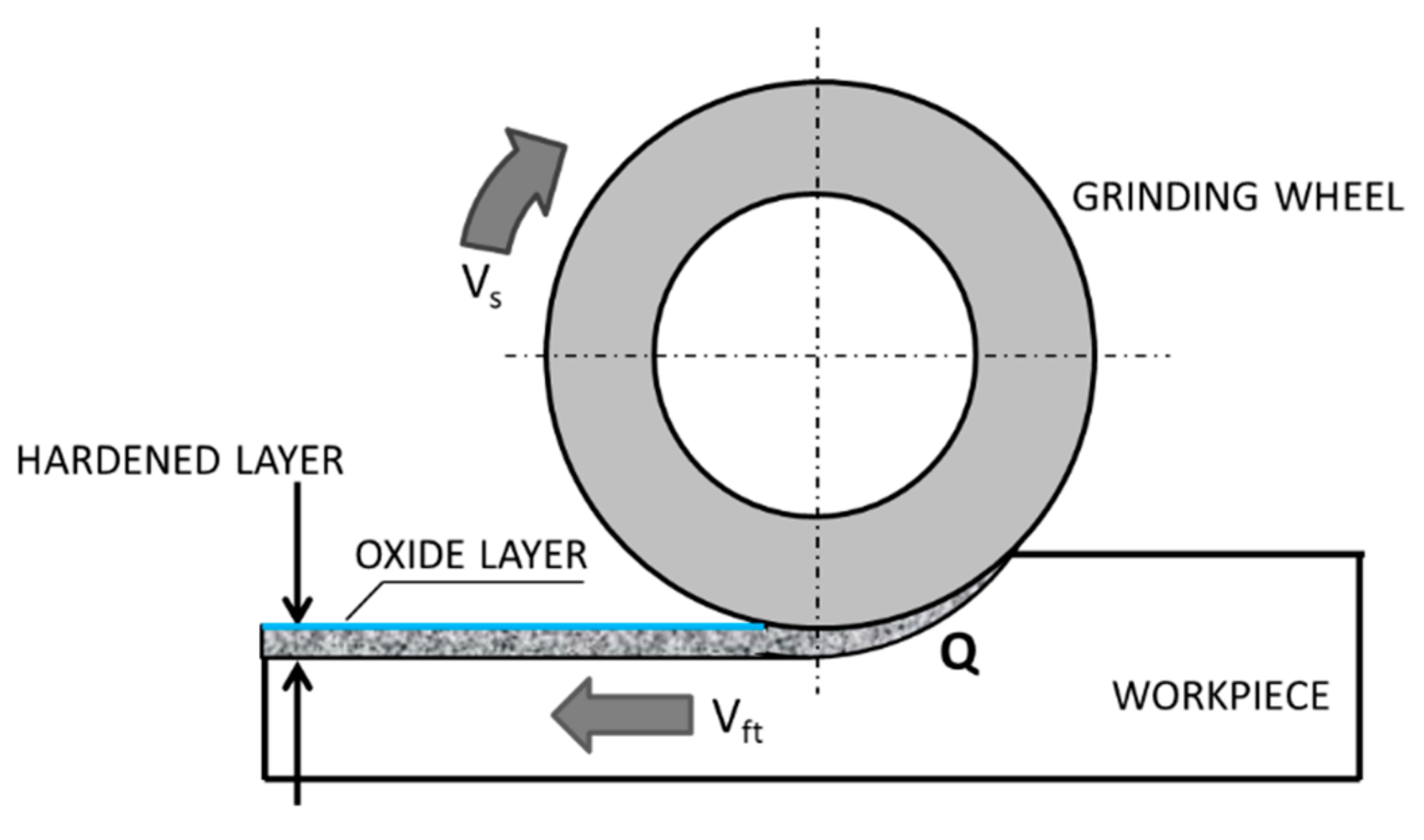
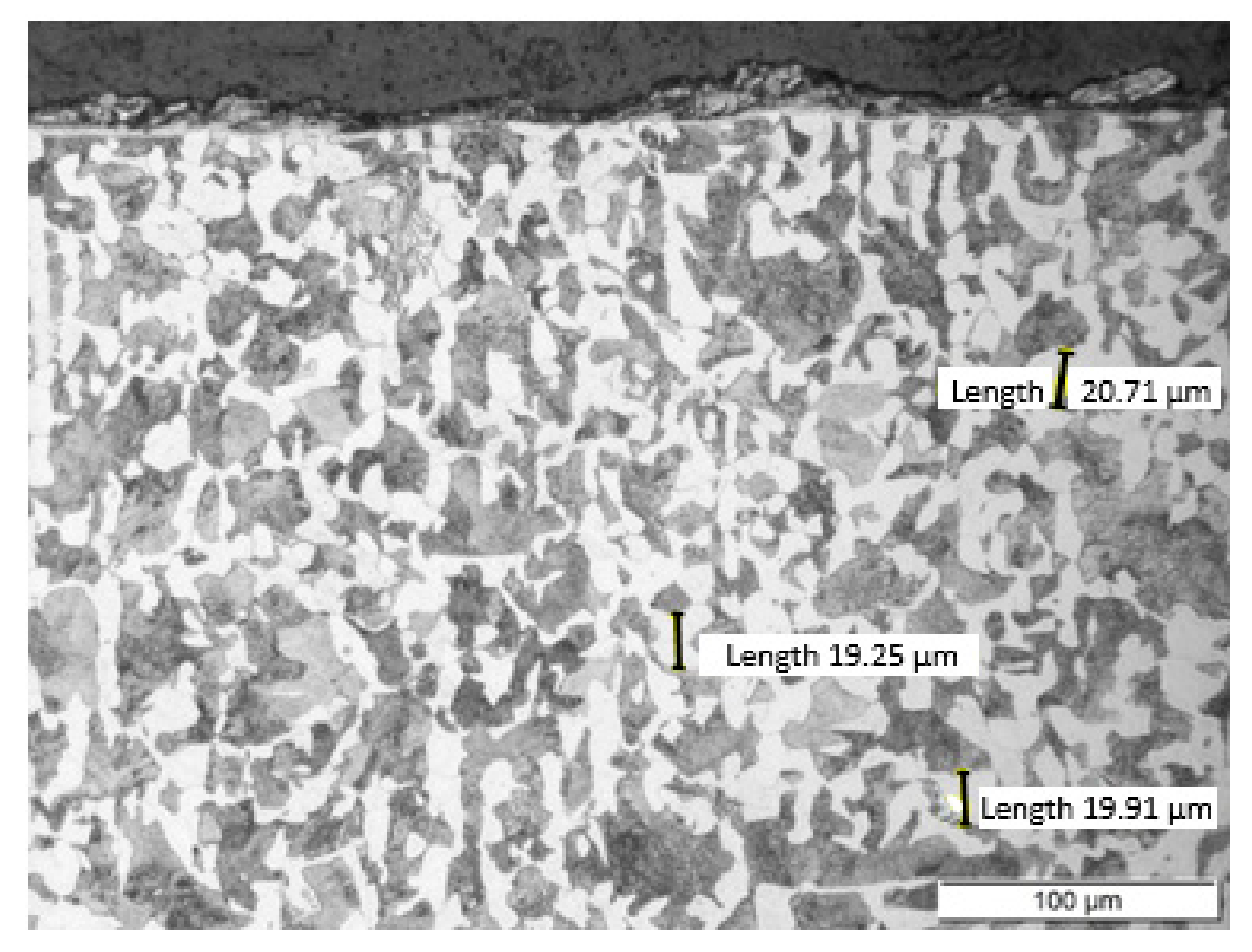
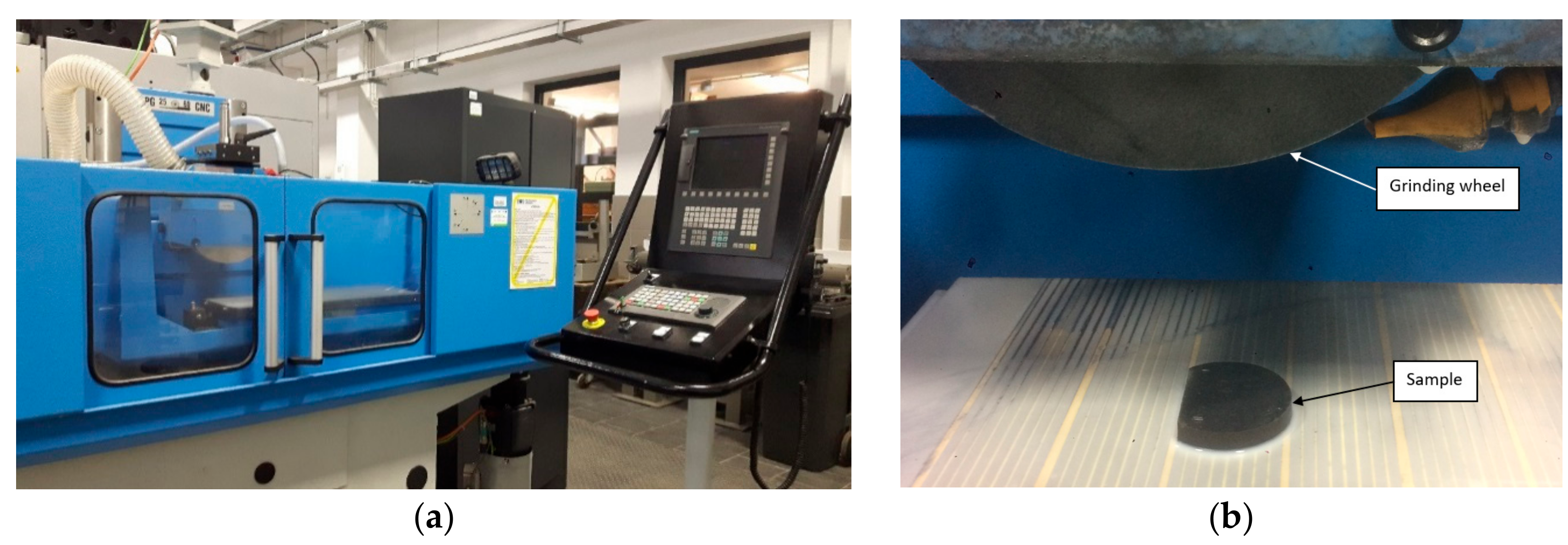
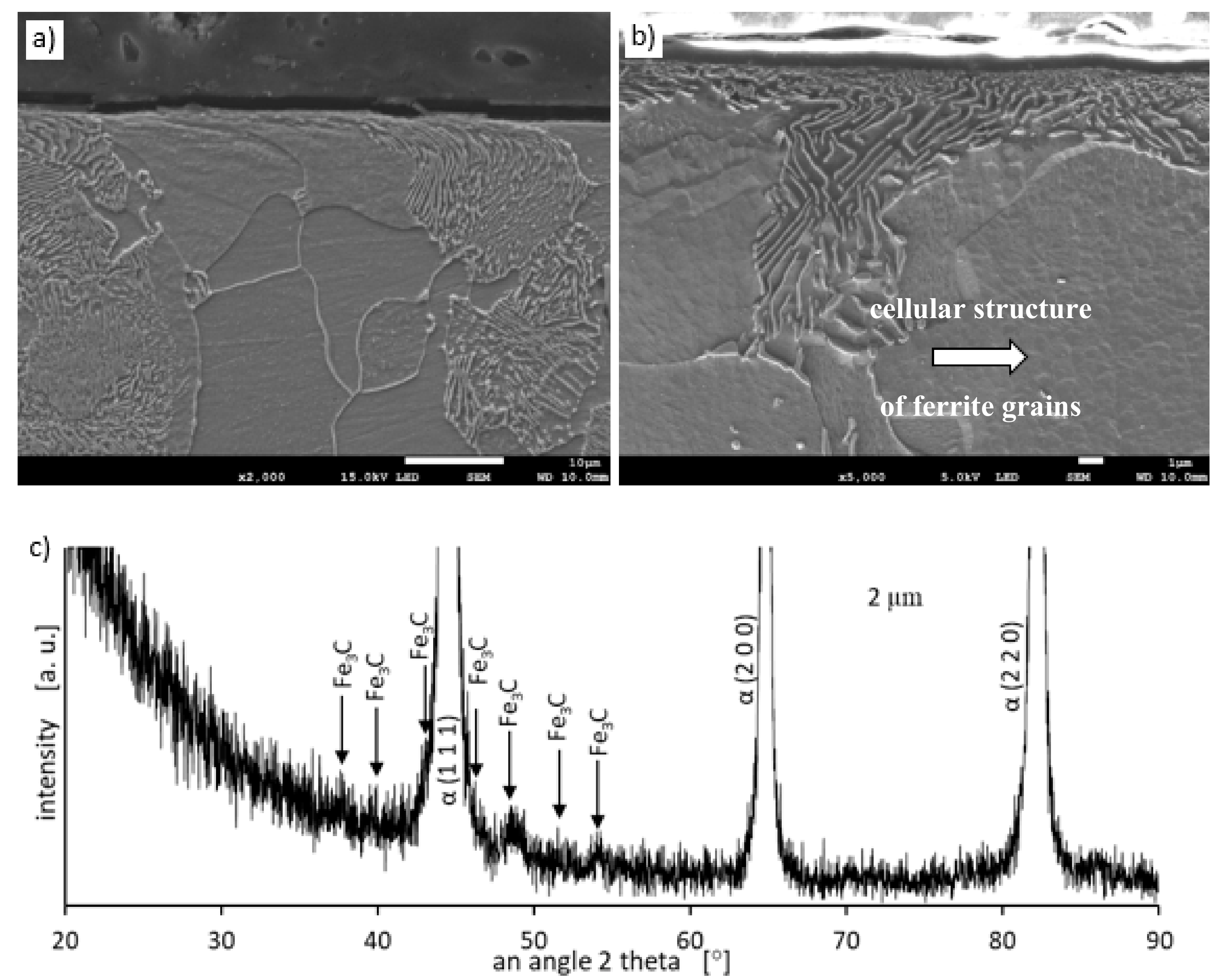
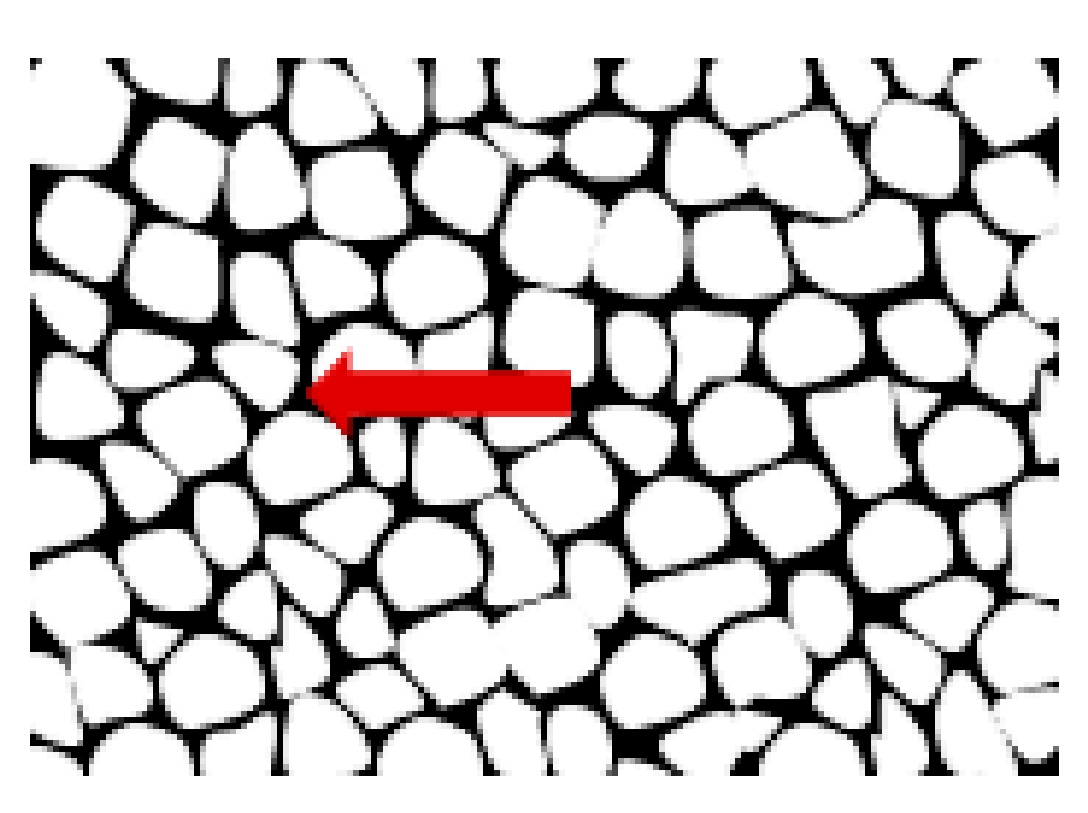
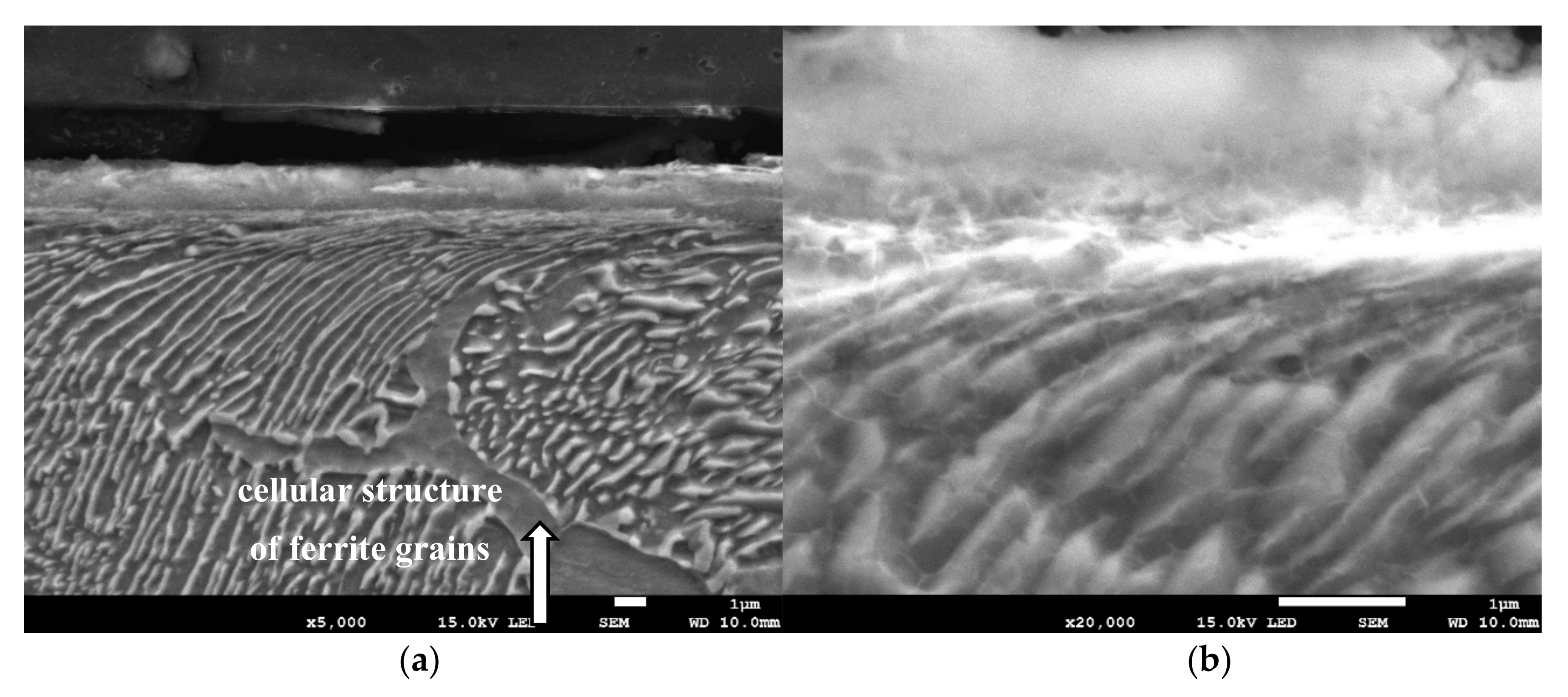
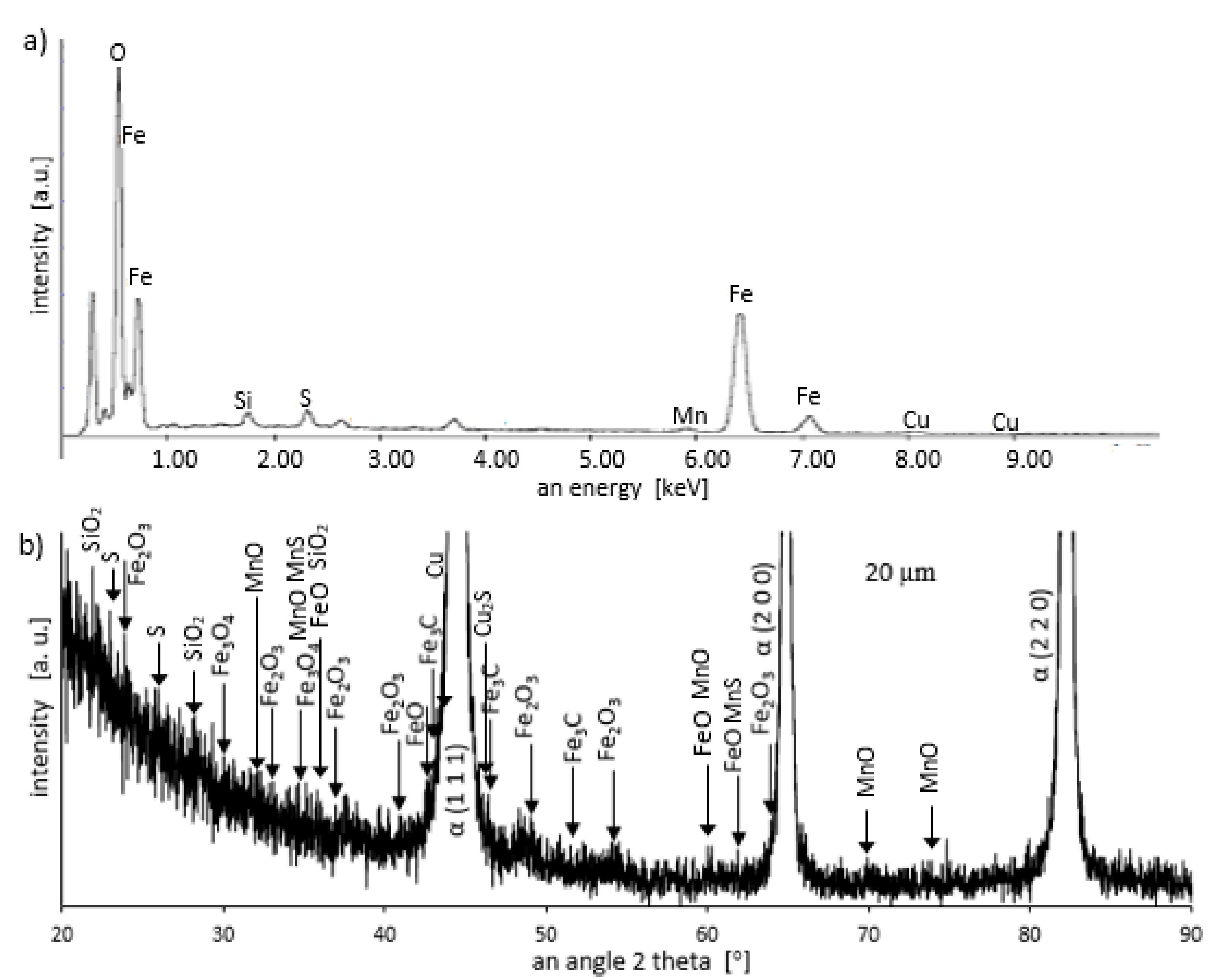
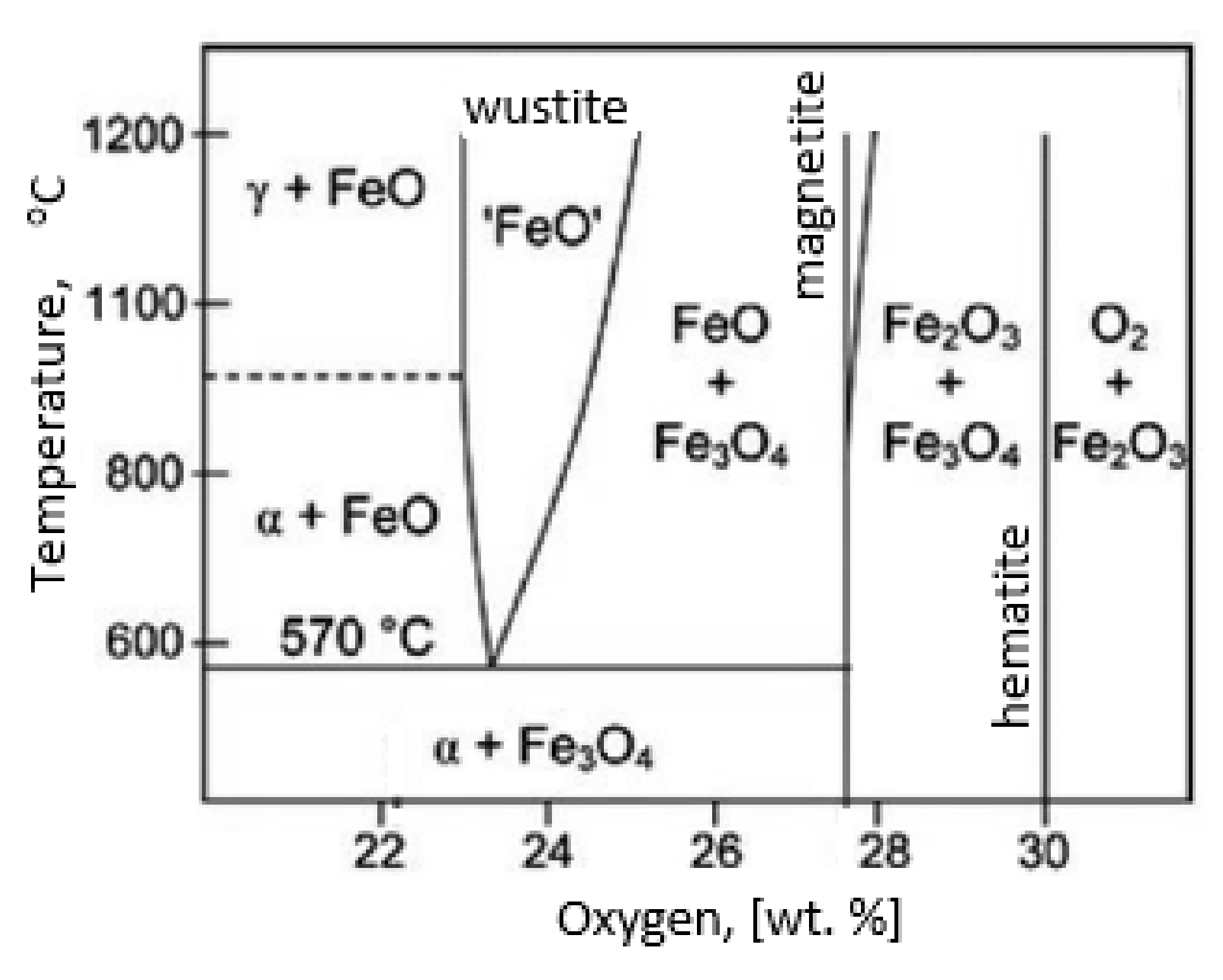
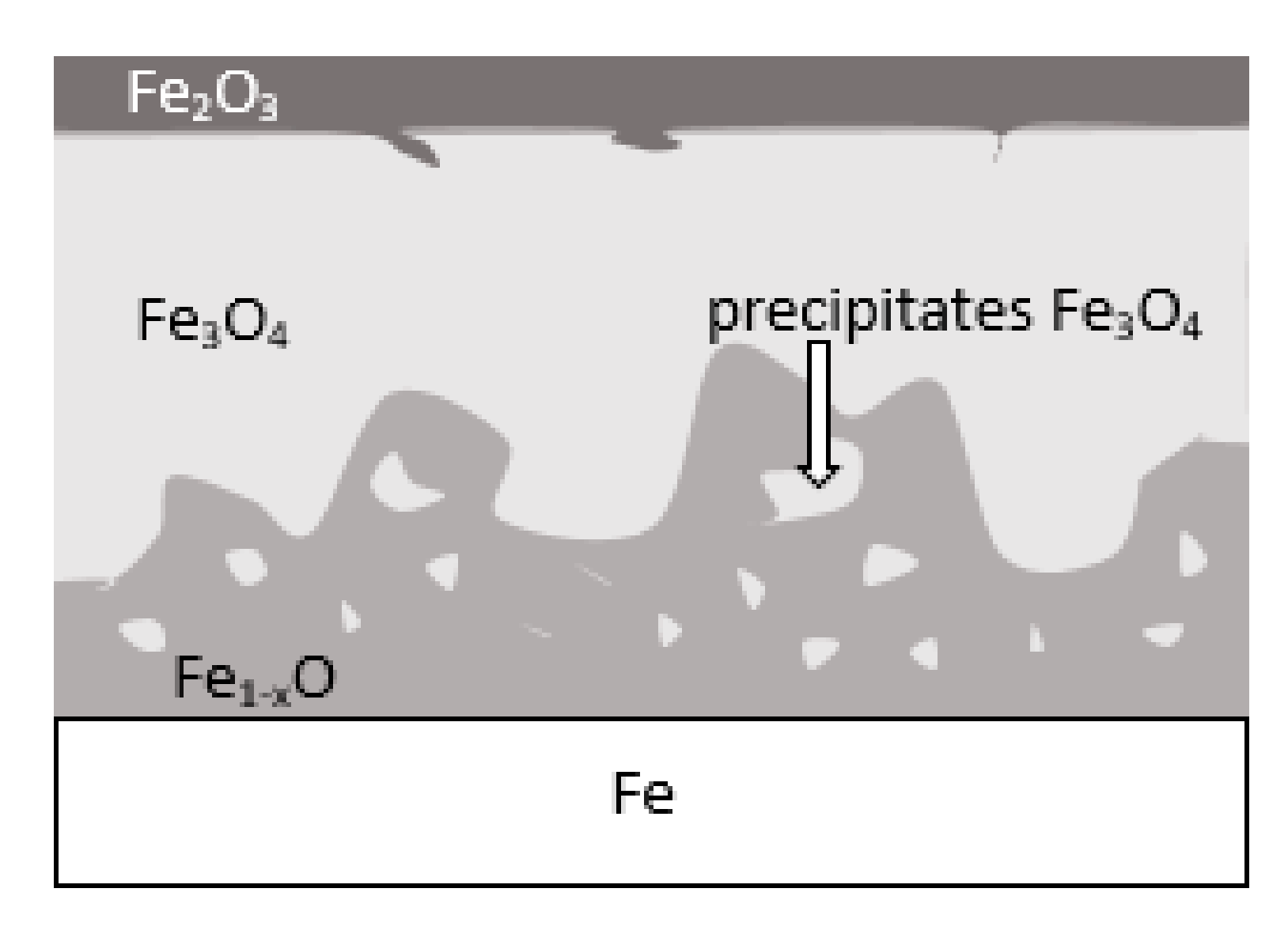
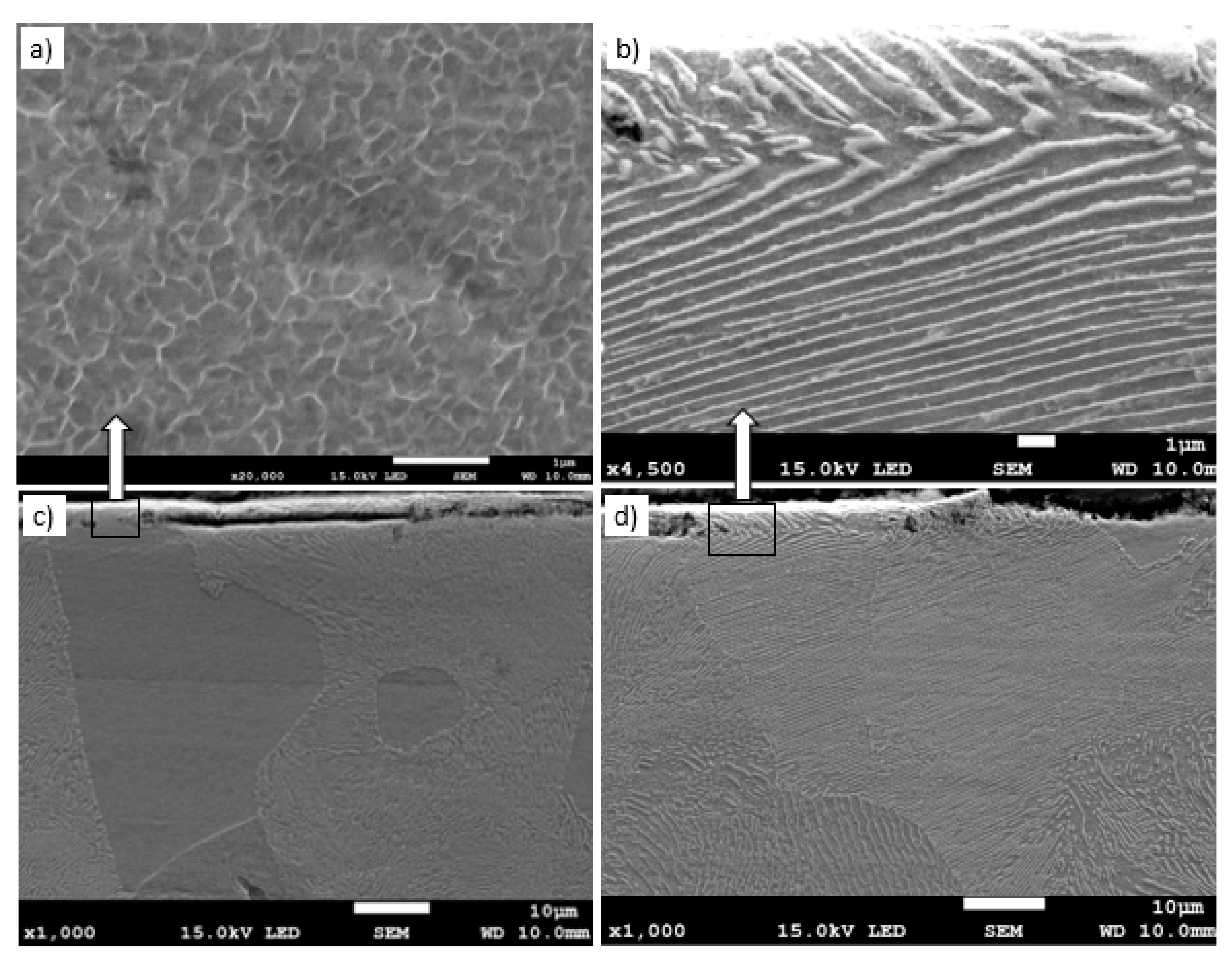
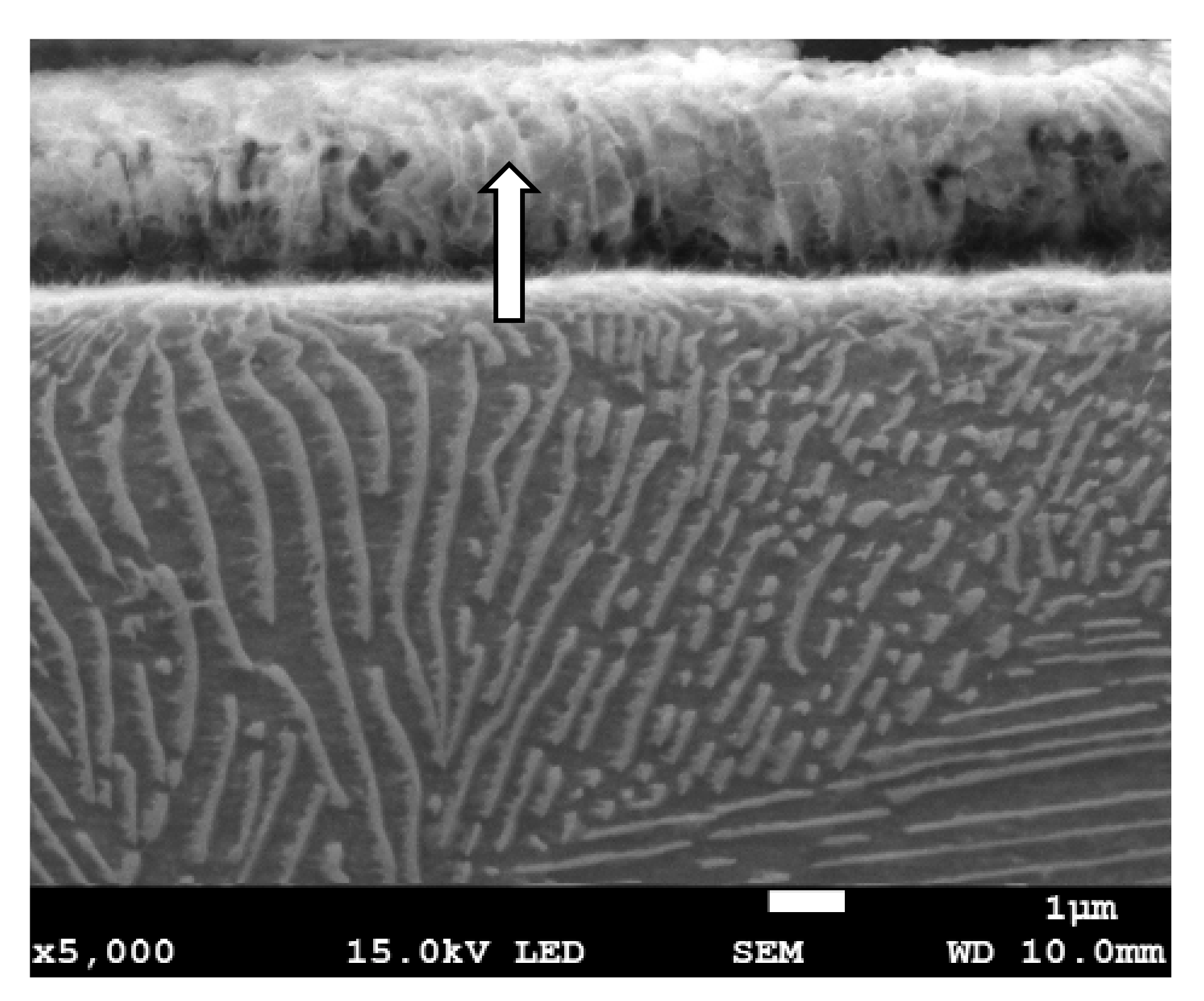
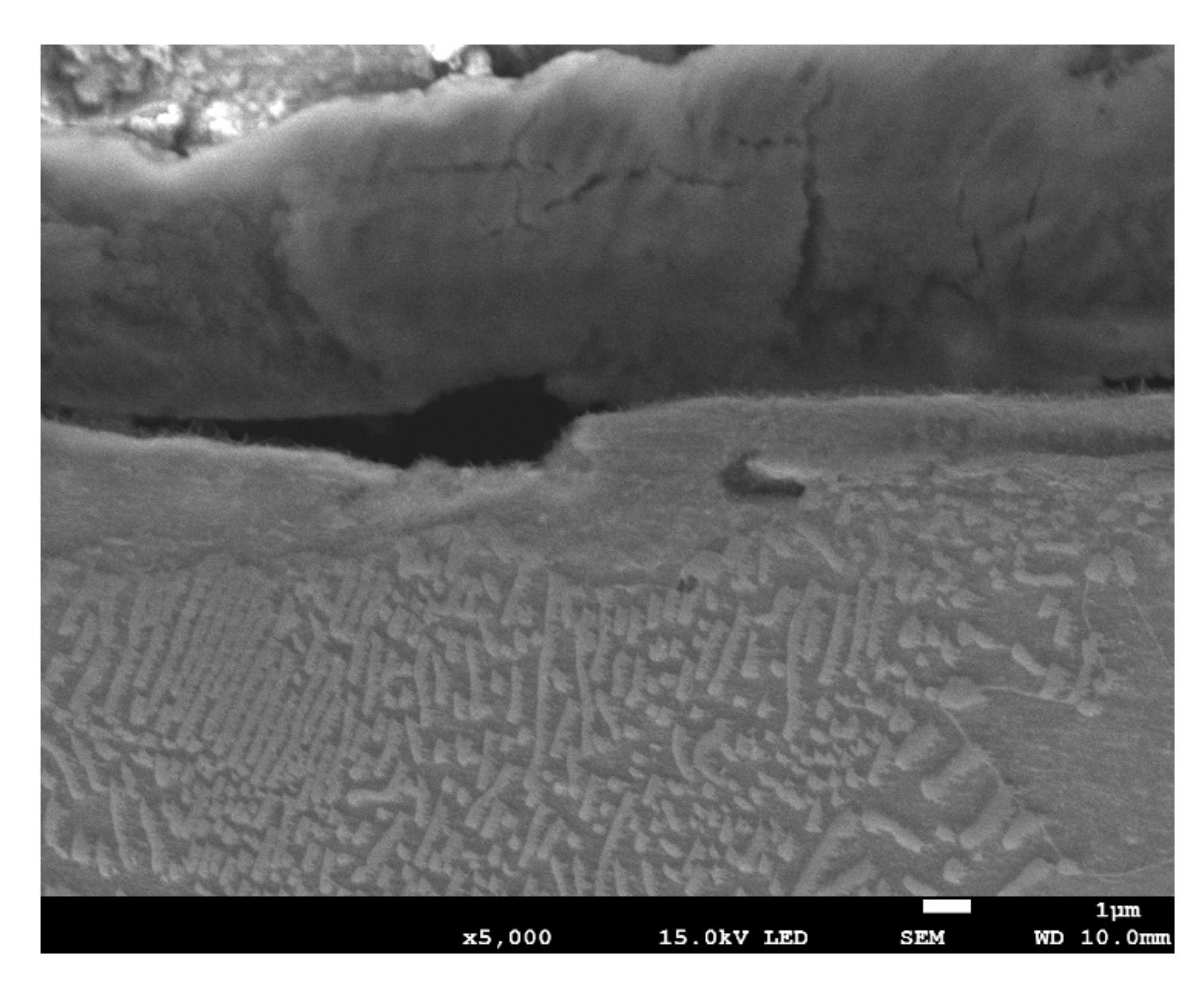
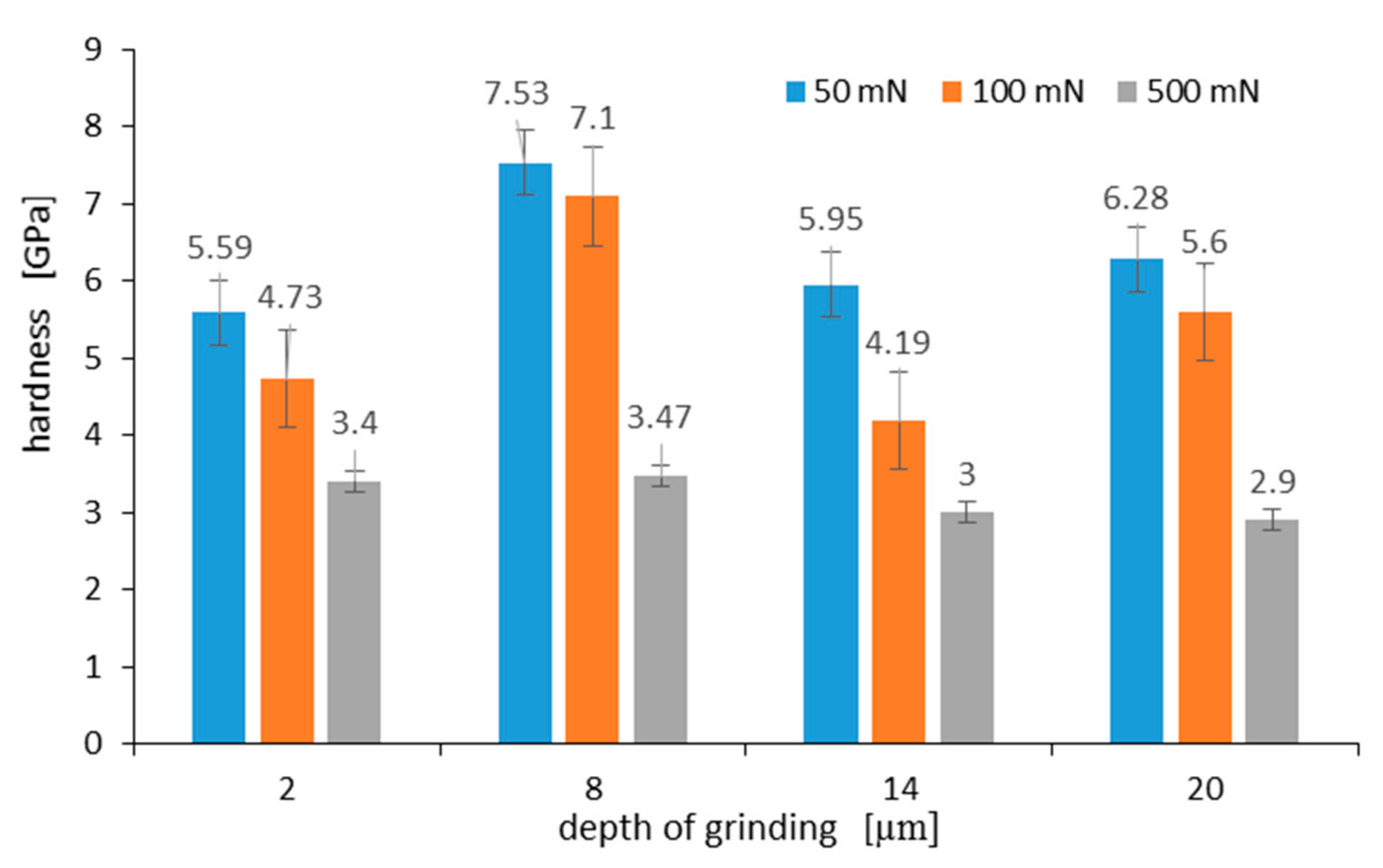
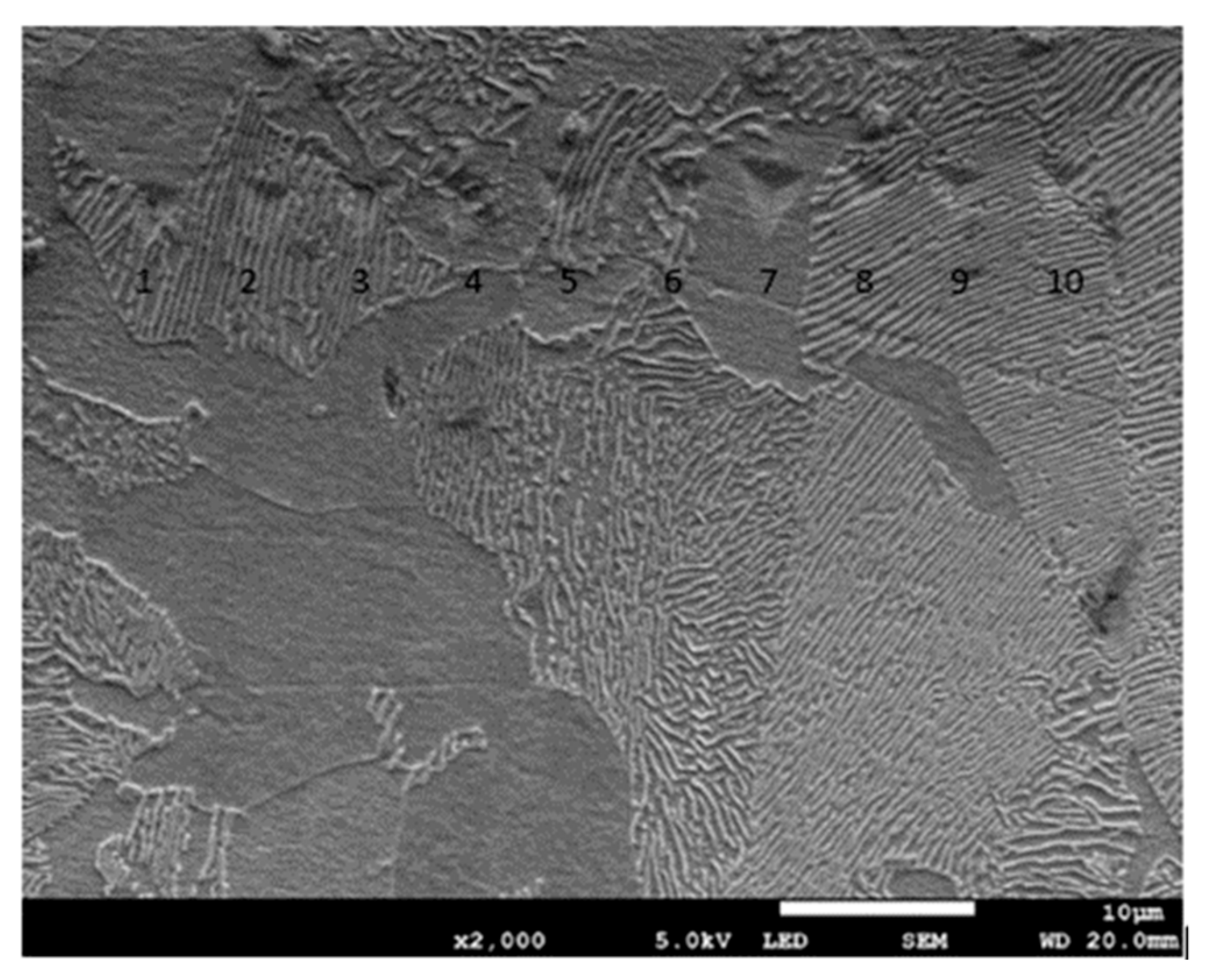
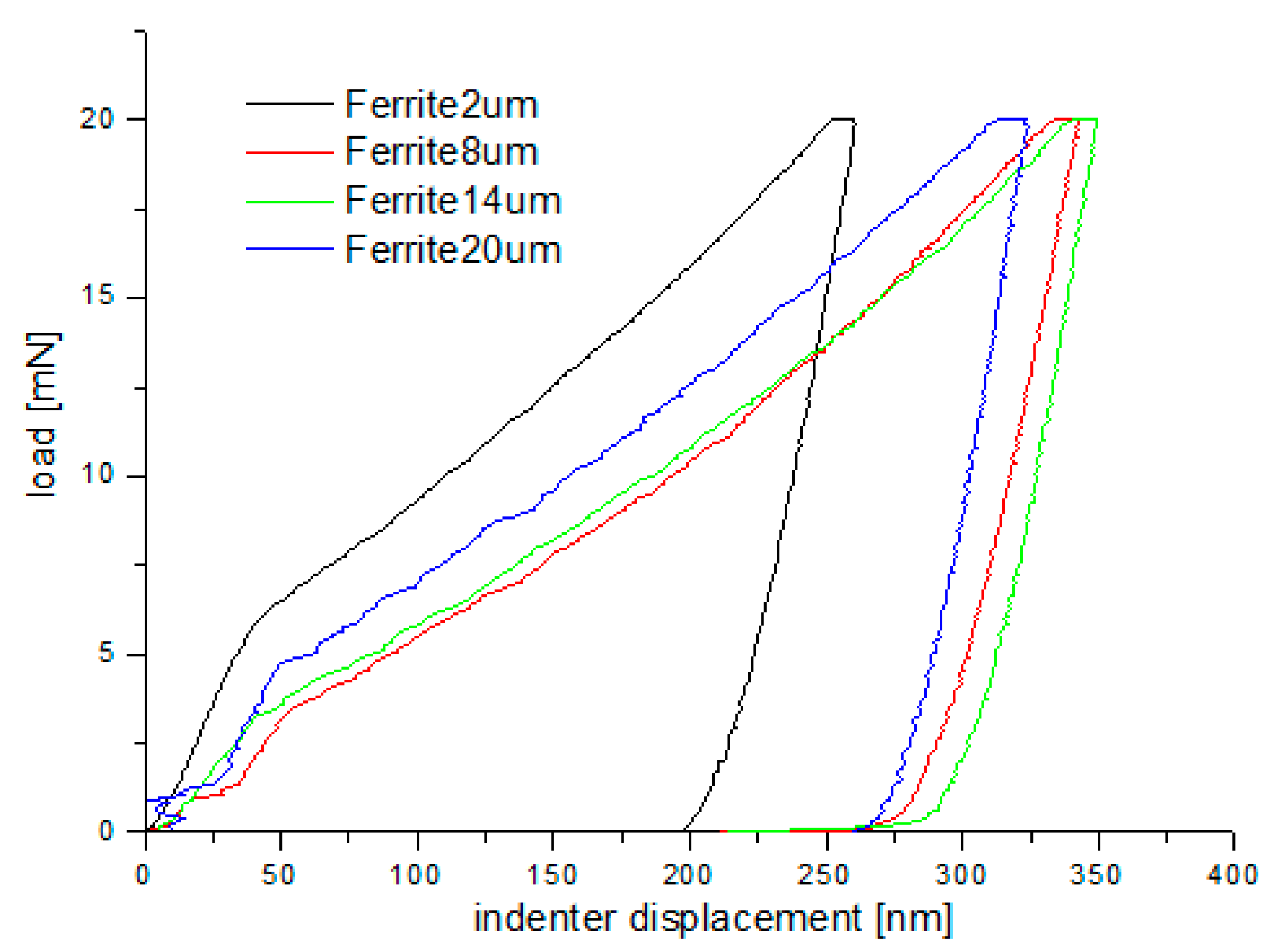

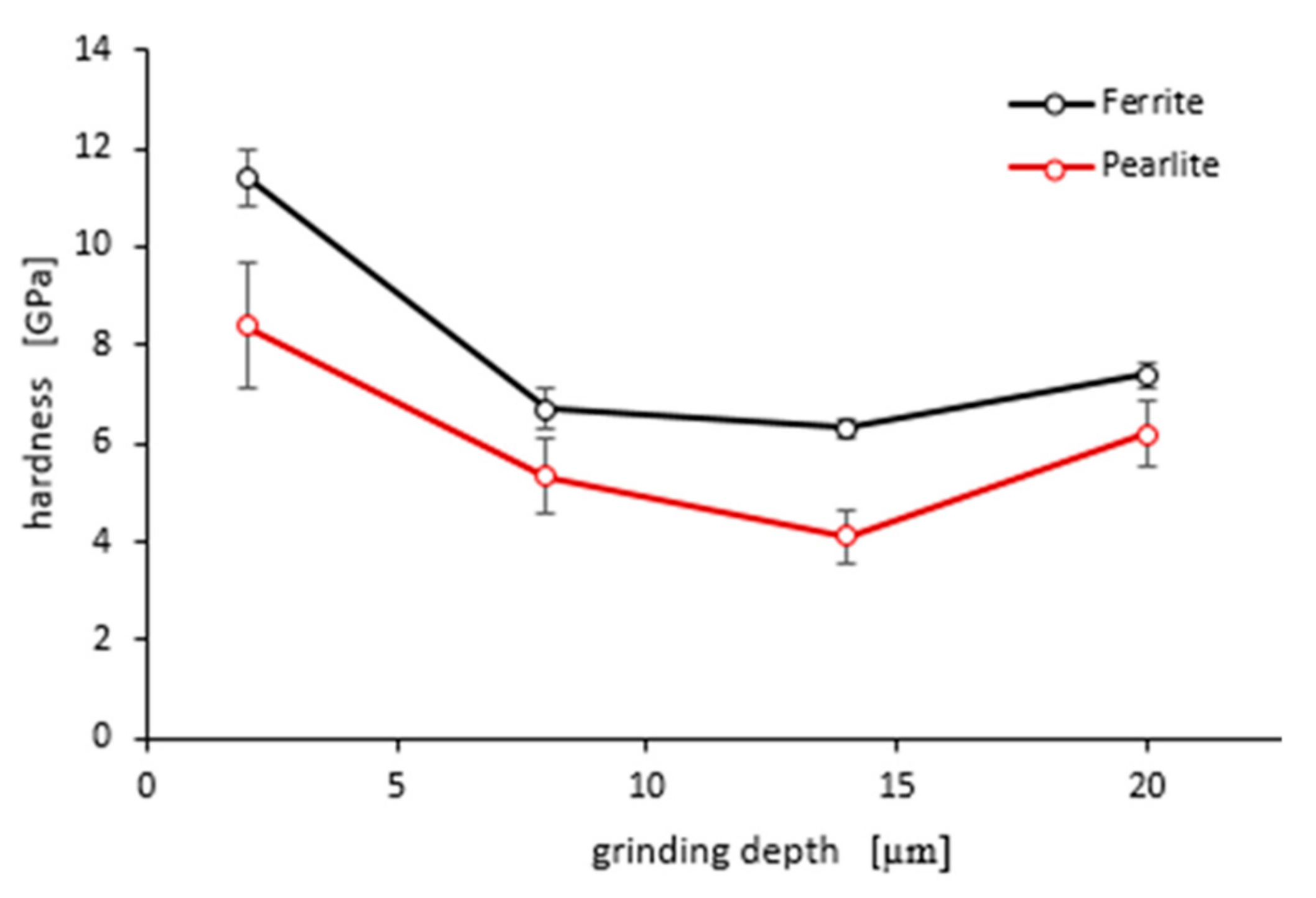
| Chemical Composition wt.% | |||||||
|---|---|---|---|---|---|---|---|
| C | Mn | Si | P | S | Cu | Cr | Ni |
| 0.47 | 0.65 | 0.27 | 0.030 | 0.025 | 0.25 | 0.17 | 0.26 |
| Element | wt.% | at.% |
|---|---|---|
| O | 32.82 | 62.05 |
| Si | 0.98 | 1.05 |
| S | 1.52 | 1.43 |
| Mn | 1.47 | 0.81 |
| Cu | 2.34 | 1.12 |
| Fe | 60.87 | 33.54 |
| Total | 100 | 100 |
© 2020 by the authors. Licensee MDPI, Basel, Switzerland. This article is an open access article distributed under the terms and conditions of the Creative Commons Attribution (CC BY) license (http://creativecommons.org/licenses/by/4.0/).
Share and Cite
Szkodo, M.; Chodnicka-Wszelak, K.; Deja, M.; Stanisławska, A.; Bartmański, M. The Influence of the Depth of Cut in Single-Pass Grinding on the Microstructure and Properties of the C45 Steel Surface Layer. Materials 2020, 13, 1040. https://doi.org/10.3390/ma13051040
Szkodo M, Chodnicka-Wszelak K, Deja M, Stanisławska A, Bartmański M. The Influence of the Depth of Cut in Single-Pass Grinding on the Microstructure and Properties of the C45 Steel Surface Layer. Materials. 2020; 13(5):1040. https://doi.org/10.3390/ma13051040
Chicago/Turabian StyleSzkodo, Marek, Karolina Chodnicka-Wszelak, Mariusz Deja, Alicja Stanisławska, and Michał Bartmański. 2020. "The Influence of the Depth of Cut in Single-Pass Grinding on the Microstructure and Properties of the C45 Steel Surface Layer" Materials 13, no. 5: 1040. https://doi.org/10.3390/ma13051040
APA StyleSzkodo, M., Chodnicka-Wszelak, K., Deja, M., Stanisławska, A., & Bartmański, M. (2020). The Influence of the Depth of Cut in Single-Pass Grinding on the Microstructure and Properties of the C45 Steel Surface Layer. Materials, 13(5), 1040. https://doi.org/10.3390/ma13051040








